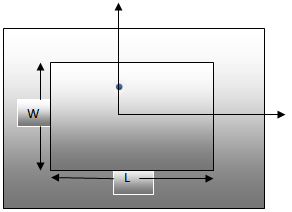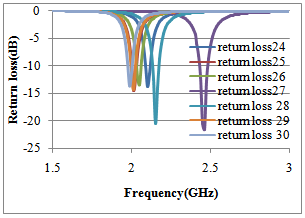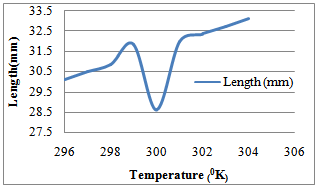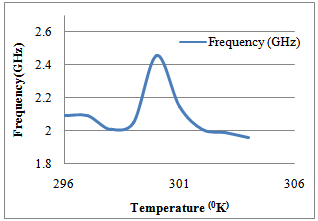Ravindra Kumar Yadav 1, Jugul Kishor 1, Ram Lal Yadava 2
1Department of Electronics and Communication Engineering, I.T.S Engineering College, Gr. Noida, Uttar Pradesh, India
2Department of Electronics and Communication Engineering, Galgotia's College of Engineering and Technology, Gr. Noida, Uttar Pradesh, India
Correspondence to: Ravindra Kumar Yadav , Department of Electronics and Communication Engineering, I.T.S Engineering College, Gr. Noida, Uttar Pradesh, India.
| Email: |  |
Copyright © 2012 Scientific & Academic Publishing. All Rights Reserved.
Abstract
Present paper describes the effects of temperature variations on the performances of rectangular patch antenna exposed to different temperatures. The antenna is designed at room temperature 300 0K with operating frequency 2.45 GHz and bandwidth 0.0518 GHz, return loss -21.83 dB and impedance 50 ohms are observed. When the temperature is decreased the value of frequency, bandwidth and impedance reduce up to 2.01 GHz, 0.0272 GHz and 35.95 ohm respectively and return loss of antenna is increased up to -13.46 dB. However if temperature is increased the value of frequency, bandwidth and impedance of antenna reduce up to 1.96 GHz, 0.0272 GHz, and 35.05 ohm respectively and return loss of antenna is increase up to -12.61 dB. Bandwidth of the antenna shows a negligible change while impedance reduces when temperature rise.
Keywords:
Microstrip Antenna, Rectangular Microstrip Patch Antenna (RMSA), Temperature Variations
Cite this paper: Ravindra Kumar Yadav , Jugul Kishor , Ram Lal Yadava , Effects of Temperature Variations on Microstrip Antenna, International Journal of Networks and Communications, Vol. 3 No. 1, 2013, pp. 21-24. doi: 10.5923/j.ijnc.20130301.03.
1. Introduction
In recent years the researchers are highly interested in the field of microstrip patch antennas due to its low cost, easy fabrication and conformability. But the poor stability of such antennas under different meteorological conditions; temperature change, limits its uses in many applications. This is because; during a year the environment temperature depending on the geographical position varies in the range from-50℃ to+50℃. And under the influence of solar radiation the upper limit for the antenna heating temperature can reach much larger values, hence may affect the antenna performances. The significant research has been made in this direction, and shown that temperature has a great effect on the antenna performances[1].In general a microstrip antenna is required to operate in an environment condition that is close to what is defined as room or standard conditions. However, in many applications antennas also have to function in harsh environments characterized by temperature variations. In this case, the antenna substrate properties suffer from some variations causing deterioration in the overall performance of a microstrip antenna. Thus for the microstrip antennas fixed on a projectile that fly for a long duration, the temperature will be an issue for the performance of that antenna. This is because the temperature variation, changes the dielectric constant of the substrate, causing expansion in the material length.Therefore the main purpose of present research is to examine the effects of temperature variations on the characteristics of rectangular patch antenna. Accordingly a rectangular patch antenna has been designed and exposed to different temperatures, and responses have been studies using HFSS (High Frequency Structure Simulator). It has been observed that as the temperature increases, the effective dielectric constant of the substrate increases, on the other hand, the resonance frequency decreases with increasing temperature. While VSWR (Voltage Standing Wave Ratio) and return loss decreases with increase the temperature.
2. Temperature's Effect on an Antenna
It has been reported that antenna temperature and the temperature of its environment correlates to its radiation resistance. According to "Antenna and Wave Propagation", [2] the noise temperature of a loss-less antenna is equal to the sky temperature and not the physical temperature, and higher temperatures equal a higher radiation resistance. This increases the signal loss of the antenna and interferes with the performance of the antenna. While according to "Distributed Sensor Networks" when the dew point (or frost point) is reached antenna surface, this effectively can raise antenna height. Since the ground plane of the antenna helps in amplifying the antenna's signal, the dew and frost thus nullifies the effect of the ground plane[3-4]. If the temperature of an antenna's material is high enough, the antenna's dielectric constant falls. This interferes with the antenna's ability to receive signals well. High temperatures can also cause degradation of the antenna's materials. If the ground plane begins to fall apart, it will not function well.Mickeen has proposed a linear thermal expansion which represents relation between the ratio of δl thermal and l, and temp as follows[5] | (1) |
In addition, the measured relationship between temperature and  is given by
is given by | (2) |
As a result new length/width of the microstrip antenna[5] will be calculated by | (3) |
Hence the resonant frequency of RMSA can be obtained using[8] | (4) |
Wherec = velocity of lightεe=effective dielectric constant | (5) |
The width of the patch is not critical it can be calculated using | (6) |
The relative-frequency change for small dimensional changes may be expressed in terms of linear dimensions in terms of temperature changes as follows[4]; | (7) |
Whereδf = change in resonant frequencyδL = change in effective resonant dimensionsαt = thermal expansion coefficient δT = temperature change in℃.Which may also relates | (8) |
Where thermal expression coefficient
thermal expression coefficient change in relative dielectric constant
change in relative dielectric constant frequency determining length of the microstrip antennaf0 = resonant frequency of a microstrip antenna
frequency determining length of the microstrip antennaf0 = resonant frequency of a microstrip antenna at 100℃.However it turns out that changes in linear dimensions of patch antenna due to thermal expression tend to compensate the effect of a changing dielectric constant. Hence, combining equation (4) and (5) we get
at 100℃.However it turns out that changes in linear dimensions of patch antenna due to thermal expression tend to compensate the effect of a changing dielectric constant. Hence, combining equation (4) and (5) we get | (9) |
Thus, with proper selection of materials, it is possible to almost eliminate temperature effects on the resonant frequency of microstrip patch antenna.
3. Design Specifications
A basic rectangular patch antenna at room temperature is designed with the help of HFSS using design parameters given in table 1. However the basic geometry of patch antenna is shown in figure 1.| Table 1. Antenna design parameters |
| | Parameter of Antenna | | Length | 28.6 mm | | Width | 37.26 mm | | Feed Location | 9 mm | | Substrate | FR-4, εr =4.4, h =0.8mm | | Frequency | 2.45 GHz |
|
|
 | Figure 1. Basic geometry of a rectangular MSA |
4. Effect of Temperature on the RMSA
 | Figure 2. Variation in return loss with change in temperature |
 | Figure 3. Variation in Antenna impedance with change in temperature |
| Table 2. Analysis at different values of temperature |
| | S. No | Temperature(0K) | Length(mm) | Frequency(GHz) | Bandwidth(GHz) | Return Loss(dB) | Impedance(Ω) | | 1 | 296 | 30.1 | 2.09 | 0.0395 | -16.6 | 40.74 | | 2 | 297 | 30.48 | 2.09 | 0.0296 | -13.75 | 35.95 | | 3 | 298 | 30.85 | 2.01 | 0.0323 | -14.38 | 36.96 | | 4 | 299 | 31.83 | 2.05 | 0.0272 | -13.46 | 36.27 | | 5 | 300 | 28.6 | 2.46 | 0.0518 | -21.83 | 50 | | 6 | 301 | 31.98 | 2.15 | 0.0444 | -20.52 | 44.08 | | 7 | 302 | 32.36 | 2.01 | 0.0321 | -14.31 | 36.6 | | 8 | 303 | 32.74 | 1.99 | 0.0294 | -13.68 | 35.27 | | 9 | 304 | 33.12 | 1.96 | 0.0272 | -12.61 | 35.05 |
|
|
 | Figure 4. Variation in length with change in temperature |
 | Figure 5. Variation in frequency with change in temperature |
 | Figure 6. Variation in bandwidth with change in temperature |
The resonant frequency of a MSA is sensitive to temperature variations[6-7]. Hence the effect of temperature on a resonance frequency, input impedance, VSWR, bandwidth and return loss on the performance of a rectangular microstrip antenna (RMSA) are demonstrated during studying. Figure 1 shows the effect of temperature on the expansion of the length of the RMSA. Due to the expansion in the length of the RMSA its electrical size increases then the resonant frequency of the patch antenna decreases. Other parameter such as return loss, impedance and are also decreased due to change in length of the antenna as shown in the Figure 1 & 2. The bandwidth curves for RMSA was similar in their dependence on temperature to resonant frequency curves. The bandwidth of RMSA decreases with increase in temperature (Figures 3-5), however the overall performance of the antenna under the influence of temperature changes is maintained in Table 2.
5. Results and Discussions
The proposed antenna is designed at room temperature 300 0K and frequency 2.45 GHz, and temperature changes are analyzed using hfss. From the obtained results, it is found that the length of the antenna ranges from 30.1 mm at 23℃ (5% change) to 33.12 mm at 31℃ (15% change). Bandwidth of the antenna shows a negligible change while impedance reduces when temperature rise. When the temperature is decreased the value of frequency, bandwidth and impedance reduce up to 2.01 GHz, 0.0272 GHz and 35.95 ohm respectively and return loss of antenna is increased up to -13.46 dB. On the hand when temperature is increased the value of frequency, bandwidth and impedance of antenna reduce up to 1.96 GHz, 0.0272 GHz, and 35.05 ohm respectively and return loss of antenna is increase up to -12.61dB. These results degrade the performance of antenna. Hence designing of antenna must be done in such a manner that these effects will be compensated. This compensation can be done by choosing specific material so that it will neutralize or reduces the effects and this can be further used as universal antenna.
References
| [1] | A. Elrashidi , K. Elleithy and H. Bajwa, “The performance of a cylindrical microstrip printed antenna for TM10 mode as a function of temperature for different substrates,” International Journal of Next-Generation Networks (IJNGN) ,Vol.3, No.3, pp.1-18 September 2011. |
| [2] | R. L. Yadava, “Antennas and wave propagation,” PHI, Learning, 1/ed, India, 2011. |
| [3] | S. Babu and G. Kumar, “Parametric study and temperature sensitivity of microstrip antennas using an improved linear transmission line Model,” IEEE Transactions on Antennas and Propagation, Vol. 47, No. 2, pp.221-226, February 1999. |
| [4] | K. Carver, and J. Mink, “Microstrip antenna technology,” IEEE Transaction on Antennas and Propagation, Vol. AP.29, No. 1, pp.1-24, January 1981. |
| [5] | L. W. Mckeen, “The effect of temperature and other factors on plastic and elastomers,” William Andrew, New York, 2007. |
| [6] | E. C. Balmain, and K. G. Jordan, “Electromagnetic wave and radiating systems,”Second Edition, Prentice-Hall electrical engineering series, June 1968. |
| [7] | P. Kabacik, and M. Bialkowski, “The temperature dependence of substrate parameters and their effect on microstrip antenna performance,” IEEE Trans. on Antennas and Propag., Vol. 47, No. 6, pp. 1042-1049, Jun. 1999 |
| [8] | G. Kumar and K. P. Ray, Broadband Microstrip Antennas, Artech House, Inc., Norwood, MA, 2003. |


 is given by
is given by






 thermal expression coefficient
thermal expression coefficient change in relative dielectric constant
change in relative dielectric constant frequency determining length of the microstrip antennaf0 = resonant frequency of a microstrip antenna
frequency determining length of the microstrip antennaf0 = resonant frequency of a microstrip antenna at 100℃.However it turns out that changes in linear dimensions of patch antenna due to thermal expression tend to compensate the effect of a changing dielectric constant. Hence, combining equation (4) and (5) we get
at 100℃.However it turns out that changes in linear dimensions of patch antenna due to thermal expression tend to compensate the effect of a changing dielectric constant. Hence, combining equation (4) and (5) we get






 Abstract
Abstract Reference
Reference Full-Text PDF
Full-Text PDF Full-text HTML
Full-text HTML